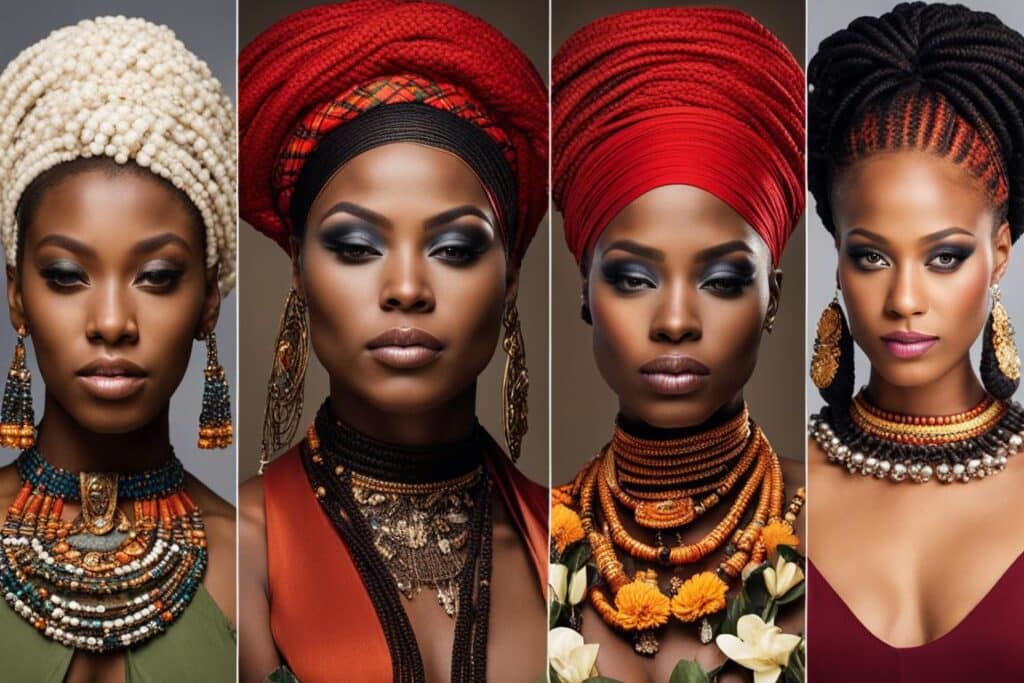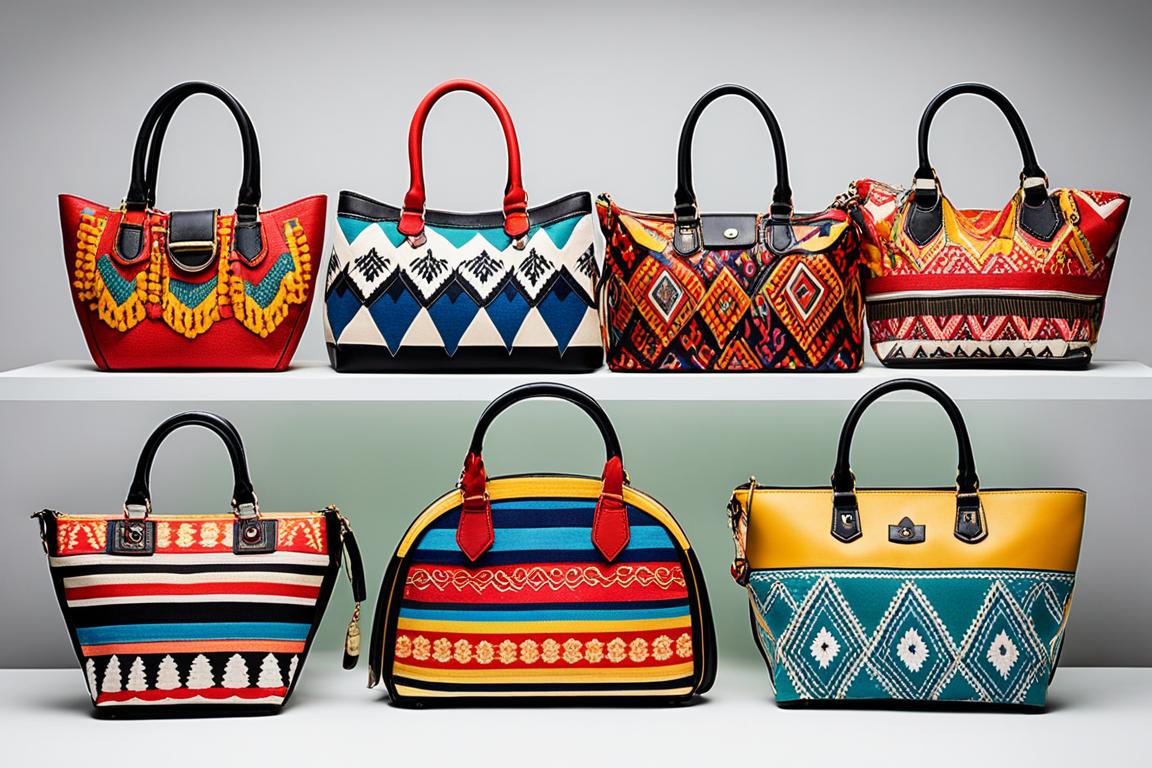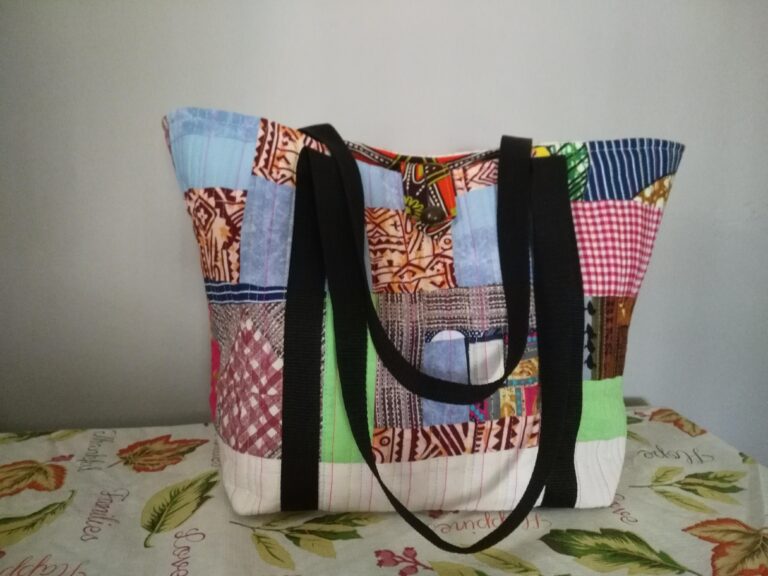Global Inspirations: Exploring How Cultural Heritage Shapes Ethnic Handbag Designs
Did you know that cultural heritage has a profound impact on the design of ethnic handbags? The incorporation of cultural elements in fashion is a powerful way to celebrate diversity and honor the traditions of different communities. From intricate patterns and traditional materials to unique crafting techniques, these handbags are steeped in cultural significance, reflecting the stories, experiences, and identities of the people and communities they represent.
Key Takeaways:
- Cultural heritage plays a significant role in shaping the aesthetics and craftsmanship of ethnic handbag designs.
- It is important for fashion brands to approach cultural significance with mindfulness and respect.
- Cultural sustainability in fashion emphasizes the preservation and passing down of traditional techniques and knowledge.
- Fashion’s influence extends beyond clothing to include hairstyling, makeup, and accessories.
- Handmade ethnic bags offer unique designs, support local communities, and promote ethical and sustainable fashion practices.
Cultural Sustainability in Fashion
Cultural sustainability in fashion involves the conscious use and adaptation of cultural heritage to ensure its preservation and transmission to future generations. It encompasses the diverse meanings and values embedded in different cultural traditions, allowing for a deeper understanding and appreciation of cultural heritage. In the context of fashion, cultural sustainability extends beyond the aesthetics and extends to the production methods and practices employed by the industry.
Weaving is an example of a traditional craft that has shaped cultural identities across the world. It represents not only the skill and artistry of the weavers but also carries the stories and history of a particular culture. By incorporating weaving techniques and materials into fashion, designers can celebrate cultural identity and contribute to cultural sustainability.
The traditional attire of various ethnic groups and indigenous communities also plays a crucial role in preserving and honoring cultural heritage. These garments often embody the unique cultural symbols, techniques, and materials that have been passed down through generations, emphasizing the importance of cultural preservation in fashion.
The fashion industry has the opportunity to adopt sustainable production methods and practices from ethnic groups and indigenous communities to promote equitable and sustainable fashion. By embracing traditional techniques, utilizing natural and locally sourced materials, and supporting fair trade practices, fashion brands can foster a more sustainable and conscious approach to production.
However, the adoption of sustainable practices in the fashion industry does come with challenges. Scalability is a key consideration, as many traditional techniques and materials may have limited availability or require specialized skills. Moreover, cultural appropriation remains a complex issue to navigate, as designers must be mindful of respecting cultural traditions and avoiding exploitation.
Integrating cultural sustainability in fashion requires a delicate balance between celebrating cultural heritage and ensuring an equitable and respectful approach to cultural influences. By promoting sustainable production methods and supporting traditional crafts and communities, the fashion industry can contribute to the preservation of cultural diversity and foster a more inclusive and responsible fashion landscape.
Weaving and Cultural Identity
Weaving has played a significant role in shaping cultural identities across different societies. From the intricate patterns of Native American textiles to the vibrant tapestries of Ghana’s Kente cloth, weaving is not merely a technique but an expression of cultural heritage. By incorporating weaving techniques and materials into contemporary fashion, designers can celebrate cultural identities and promote cultural sustainability.
Traditional Attire and Cultural Heritage
The traditional attire of various ethnic groups and indigenous communities carries deep cultural significance and represents the embodiment of cultural heritage. From the colorful textiles of Mexican dresses to the exquisite embroidery of Chinese cheongsams, traditional attire is a visual representation of history, tradition, and identity. By incorporating elements of traditional attire into fashion, designers can honor and preserve cultural heritage while creating unique and culturally inspired designs.
| Sustainable production methods in fashion | Equitable and sustainable fashion practices |
|---|---|
| Utilizing natural and locally sourced materials | Promoting fair trade practices |
| Adopting eco-friendly manufacturing processes | Supporting transparent supply chains |
| Reducing waste and carbon footprint | Investing in renewable energy sources |
By integrating these sustainable production methods, fashion brands can contribute to cultural sustainability by ensuring a more responsible and ethical approach to fashion production.
Fashion’s Influence Beyond Clothing
Fashion goes beyond clothing and extends its influence to other aspects of personal style, including hairstyling, makeup, and accessories. These elements play a crucial role in expressing one’s identity and cultural influences.
Hairstyling and Cultural Influences
Traditional African hairstyles have gained global popularity for their unique aesthetics and cultural significance. Locs and braids, in particular, have become iconic styles that transcend borders, representing the rich heritage of African cultures. These hairstyles not only reflect beauty but also serve as symbols of identity and pride.
Makeup and Cultural Influences
Makeup also draws inspiration from different cultures, incorporating elements that reflect cultural diversity and history. From ancient Egyptian-inspired winged eyeliner to Japanese geisha-inspired white face makeup, cultural influences can be seen throughout the world of cosmetics. Makeup serves as a creative outlet for self-expression and a way to honor cultural traditions.
Accessories and Cultural Influences
Accessories play a significant role in fashion, and their designs often reflect cultural influences. Traditional Indian accessories, such as bindis, henna tattoos, and turbans, have gained international popularity and are now embraced as fashion statements. These accessories have transcended their ethnic meanings and become symbols of style and individuality.

Similarly, accessories inspired by various cultures worldwide have become staple pieces in fashion. From statement necklaces inspired by African tribal jewelry to intricate beaded bracelets representing Native American traditions, these accessories add a touch of cultural authenticity to outfits.
It is important to recognize and respect the cultural roots of these fashion trends. Understanding the significance behind these styles and accessories helps foster appreciation and cultural exchange in the fashion industry.
| Cultural Influence | Popular Hairstyle | Common Makeup Trends | Trending Accessories |
|---|---|---|---|
| Africa | Locs, Braids | Rich earthy tones, vibrant lip colors | Tribal-inspired jewelry, statement headpieces |
| India | Bun with floral adornments, intricate braids | Brightly colored eyeshadows, intricate patterns | Bindis, statement earrings, decorative scarves |
| Japan | Geisha-inspired updos, sleek bobs | Pale complexion, red lips | Hair sticks, kimono-inspired belts |
These cultural influences not only add depth and uniqueness to fashion but also serve as a reminder of the global interconnectedness of style and traditions.
Cultural Influences on Materials and Textiles in Fashion
Culture plays a significant role in shaping the materials and textiles used in fashion, reflecting the richness and diversity of global traditions. From traditional silk production in China to vibrant Ankara prints in Africa and intricate handloom textiles in India, cultural influences are deeply embedded in the fabrics that adorn our clothes.
In China, silk has a long-standing cultural significance and is intricately woven into the country’s fashion heritage. Ancient Chinese silk production techniques have been passed down through generations, resulting in exquisite silk fabrics that embody elegance, luxury, and artistry.
Africa is known for its vibrant textiles, featuring bold patterns and colors that tell stories and represent cultural identities. Ankara prints, a popular African textile, are characterized by their intricate motifs and vivid hues. These prints reflect the cultural heritage and skilled craftsmanship of the continent, capturing the essence of African fashion.
India’s handloom textiles carry a powerful cultural legacy, blending history, tradition, and artistry. These textiles are intricately woven by skilled artisans, showcasing the various regional weaving techniques and patterns that define India’s diverse cultural landscape. Indian handloom textiles not only contribute to the country’s exports but also serve as a symbol of cultural heritage and identity.
Examples of Cultural Influences on Materials and Textiles
| Region | Traditional Material | Cultural Significance |
|---|---|---|
| China | Silk | Silk production in China dates back thousands of years, representing elegance, luxury, and cultural heritage. |
| Africa | Ankara Prints | African textiles, particularly Ankara prints, are celebrated for their vibrant colors and intricate patterns that reflect the cultural diversity of the continent. |
| India | Handloom Textiles | Indian handloom textiles showcase the rich craftsmanship and cultural traditions of various regions in India, serving as a symbol of cultural legacy and identity. |
Designers often draw inspiration from these cultural materials and textile traditions to create unique and culturally-inspired designs. By incorporating elements from different cultural heritages, fashion designers celebrate diversity and promote cross-cultural appreciation.
Image:
Ethnic Fashion Trends Blending Tradition and Modernity
Ethnic fashion trends celebrate the beauty and diversity of global cultures by blending traditional craftsmanship with contemporary styles. Designers infuse traditional silhouettes with modern twists, creating innovative and fashion-forward looks that honor heritage while embracing modernity. Cultural exchange and collaboration influence ethnic fashion trends, highlighting the interconnectedness of global fashion and promoting cultural appreciation.
Statement accessories play a crucial role in ethnic-inspired outfits, reflecting the artistry and craftsmanship of different cultural traditions. These bold accessories, such as statement jewelry and handcrafted accents, add flair and uniqueness to the overall look. They serve as powerful expressions of individual style and cultural identity, elevating the outfit with their intricate designs and vibrant colors.
Modern interpretations of traditional silhouettes
“Fashion is a form of self-expression, and by blending traditional silhouettes with contemporary elements, designers create garments that tell a story of cultural heritage infused with modern innovation.”
Modern interpretations of traditional silhouettes are at the forefront of ethnic fashion trends. Designers celebrate their cultural roots by incorporating elements from traditional garments such as sarees, kimonos, or kaftans into modern fashion pieces. These garments retain the essence of their heritage while embracing contemporary cuts, patterns, and fabrics. This blending of tradition and modernity allows individuals to showcase their cultural pride with a fashion-forward twist.
Cultural exchange in fashion
Cultural exchange is a vital aspect of ethnic fashion trends. With globalization and increased connectivity, designers are inspired by different cultures worldwide, resulting in a rich tapestry of creative influences. In turn, this cultural exchange fosters mutual understanding and appreciation, breaking down boundaries and promoting inclusivity in the fashion industry.
Whether it’s incorporating motifs, prints, or weaving techniques from various cultures, designers pay homage to their inspiration sources, giving credit to the cultural traditions that have influenced their work. In doing so, they showcase the beauty and diversity of global fashion, emphasizing the power of collaboration and the positive impact cultural exchange can have.
Statement accessories in ethnic-inspired outfits
“Statement accessories are more than fashion accessories; they are cultural artifacts, intricately crafted pieces that capture the essence of different communities and traditions.”
Statement accessories play a pivotal role in ethnic-inspired outfits, serving as the perfect complement to showcase unique cultural elements. These accessories, whether it’s a beaded necklace, an embroidered clutch, or a hand-carved bracelet, add a touch of authenticity and individuality to the overall look.
| Statement Accessories in Ethnic-Inspired Outfits | Features |
|---|---|
| Handcrafted Jewelry | Intricate designs, traditional motifs, and vibrant gemstones |
| Embroidered Bags | Artful stitching, vibrant colors, and unique patterns |
| Woven Belts | Traditional weaving techniques, natural materials, and geometric patterns |
Whether it’s a necklace passed down through generations or a pair of statement earrings made by skilled artisans, these accessories imbue ethnic-inspired outfits with cultural richness and storytelling. They become meaningful symbols of cultural traditions and heritage, encouraging wearers to embrace their roots and share the beauty of diversity with the world.

With modern interpretations of traditional silhouettes, cultural exchange, and statement accessories, ethnic fashion trends continue to make a significant impact on the fashion scene. They celebrate the rich and diverse heritage of cultures worldwide, promoting inclusivity and cultural appreciation. By embracing the beauty of traditions and blending them with contemporary styles, individuals can express their unique cultural identities while staying on the cutting edge of fashion.
Handmade Ethnic Bags: Unique Accessories with Cultural Significance
Handmade ethnic bags are more than just accessories; they are intricate works of art that embody the rich heritage and individuality of diverse cultures. These unique bags are crafted using traditional materials and techniques, defying the mass-produced norms of the fashion industry.
Each handmade ethnic bag showcases a distinct design and style that reflects the cultural influences and aesthetics of the artisans who create them. From vibrant tribal motifs to delicate embroidered patterns, these bags offer a visual storytelling experience that transcends mere functionality.
Buying handmade ethnic bags is more than just a fashion statement; it is a way to support local communities and artisans. By purchasing these bags, you actively contribute to the preservation of cultural traditions and techniques, empowering artisans to continue their craft and sustain their livelihoods.
Authenticity is a cornerstone of handmade ethnic bags. Each bag is a one-of-a-kind masterpiece, reflecting the authenticity and individuality of a specific cultural heritage. From the choice of materials to the intricate craftsmanship, every detail tells a story and breathes life into the bag, making it a truly unique accessory.
In a world where mass production dominates the fashion industry, handmade ethnic bags offer a refreshing alternative. They epitomize ethical and sustainable fashion practices, emphasizing the value of traditional craftsmanship and supporting local communities. By adding a handmade ethnic bag to your collection, you not only elevate your style but also embrace the beauty of cultural authenticity.
Conclusion
Ethnic fashion is a powerful tool for celebrating cultural heritage, as it allows us to showcase the unique traditions and craftsmanship of diverse cultures. However, it is crucial to approach ethnic influences in fashion with respect and mindfulness, ensuring that cultural traditions are honored and not appropriated for commercial gain.
By embracing authenticity and diversity in fashion, we can create a more inclusive and respectful industry that values the richness of cultural heritage. This means understanding the significance of cultural influences and supporting ethical and sustainable fashion practices.
When we respect and celebrate cultural traditions, we contribute to a more harmonious and culturally aware world. Ethnic fashion has the power to bridge cultural divides and foster appreciation for the beauty and uniqueness of different cultures. Let us continue to embrace authenticity and diversity, recognizing that fashion is not just about clothing, but also about preserving and honoring the stories, experiences, and identities that these designs represent.
FAQ
How does cultural heritage influence ethnic handbag designs?
Cultural heritage plays a significant role in shaping the aesthetics and craftsmanship of ethnic handbag designs. Traditional techniques, materials, and motifs from different cultures are often incorporated into handbag styles, showcasing the diverse influences of cultural heritage.
What is cultural sustainability in fashion?
Cultural sustainability in fashion involves using and adapting cultural heritage in a way that allows future generations to understand and preserve the rich diversity of meanings and values embedded in it. It emphasizes the importance of respecting traditional techniques and knowledge while promoting equitable and sustainable practices.
How does fashion influence beyond clothing?
Fashion extends beyond clothing to include hairstyling, makeup, and accessories. Global trends like traditional African hairstyles and Indian accessories have gained popularity, often shedding their ethnic meaning and becoming fashion statements.
How do cultural influences impact materials and textiles in fashion?
Cultural influences shape the materials and textiles used in fashion. Examples include the long-standing production of silk in China, the intricate patterns and vibrant Ankara prints of African textiles, and the rich legacy of Indian handloom textiles. Designers often incorporate these cultural materials to create unique and culturally-inspired designs.
What are ethnic fashion trends?
Ethnic fashion trends blend traditional craftsmanship with contemporary styles. Designers infuse traditional silhouettes with modern twists, creating innovative looks that honor heritage while embracing modernity. The interconnectedness of global fashion and cultural exchange influences these trends.
What are handmade ethnic bags, and why are they unique?
Handmade ethnic bags are accessories characterized by their unique designs and styles influenced by diverse cultures. They are often made using traditional materials and techniques, making them distinct from mass-produced bags. Buying handmade ethnic bags supports local communities and artisans while promoting ethical and sustainable fashion practices.
What is the significance of cultural heritage in ethnic fashion?
Ethnic fashion serves as a celebration of cultural heritage, showcasing the unique traditions and craftsmanship of diverse cultures. It is crucial to respect and honor cultural traditions when drawing inspiration from ethnic influences in fashion, promoting a more inclusive and respectful industry that values the richness of cultural heritage.







